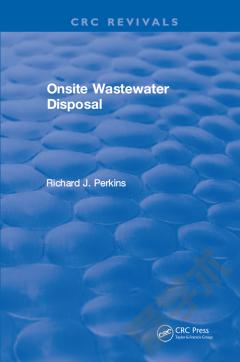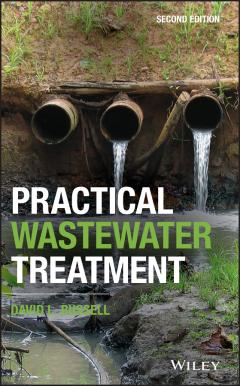Wastewater Sludge Processing
Chapter 1. Introduction. 1.1 Introduction. 1.2 40 CFR Part 503 Regulation. 1.2.1 General Provisions. 1.2.2 Land Application. 1.2.3 Surface Disposal. 1.2.4 Pathogen and Vector Attraction Reduction. 1.2.5 Incineration. Chapter 2. Sludge Quantities and Characteristics. 2.1 Types of Sludge. 2.1.1 Primary Sludge. 2.1.2 Secondary Sludge. 2.1.3 Chemical Sludge. 2.1.4 Other Wastewater Residuals. 2.2 Sludge Quantity. 2.2.1 Primary Sludge. 2.2.2 Secondary Sludge. 2.2.3 Activated Sludge. 2.2.4 Attached Growth System Sludge. 2.2.5 Chemical sludge. 2.3 Sludge Characteristics. 2.3.1 Primary Sludge. 2.3.2 Activated Sludge. 2.3.3 Physical and Biological Properties. 2.4 Mass Balance. Chapter 3. Thickening and Dewatering. 3.1 Introduction. 3.2 Conditioning. 3.2.1 Factors Affecting Conditioning. 3.2.2 Chemical Conditioning. 3.2.3 Other Conditioning Methods. 3.3 Thickening. 3.3.1 Gravity Thickening. 3.3.2 Dissolved Air Flotation Thickening. 3.3.3 Centrifugal Thickening. 3.3.4 Gravity Belt Thickening. 3.3.5 Rotary Drum Thickening. 3.3.6 Miscellaneous Thickening Methods. 3.4 Dewatering. 3.4.1 Centrifugal Dewatering. 3.4.2 Belt Filter Press. 3.4.3 Pressure Filter Press. 3.4.4 Drying Beds. 3.4.5 Other Dewatering Methods. Chapter 4. Aerobic Digestion. 4.1 Introduction. 4.1.1 Process Theory. 4.2 Conventional Aerobic Digestion. 4.2.1 Process Design Considerations. 4.2.2 System Design Considerations. 4.2.3 Operational Considerations. 4.3 Process Variations. 4.3.1 High-Purity Oxygen Digestion. 4.3.2 Low Temperature Aerobic Digestion. 4.3.3 Dual Digestion. 4.3.4 Mesophilic Aerobic Digestion. 4.3.5 Autothermal Thermophilic Aerobic Digestion. 4.3.6 Technological Improvements. Chapter 5. Anaerobic Digestion. 5.1 Introduction. 5.1.1 Advantages and Disadvantages. 5.1.2 Theory of Anaerobic Digestion. 5.2 Environmental Factors. 5.2.1 Solids and Hydraulic Retention Times. 5.2.2 Temperature. 5.2.3 pH and Alkalinity. 5.2.4 Toxic Materials. 5.3 Process Variations. 5.3.1 Low-Rate Digestion. 5.3.2 High-Rate Digestion. 5.3.3 Thermophilic Digestion. 5.3.4 Two-Stage Digestion. 5.3.5 Two-Phase Digestion. 5.4 Process Design. 5.4.1 Per Capita Basis. 5.4.2 Solids Loading. 5.4.3 Solids Retention Time. 5.4.4 Volatile Solids Reduction. 5.4.5 Gas Production. 5.5 System Component Design. 5.5.1 Tank Design. 5.5.2 Digester Covers. 5.5.3 . 5.5.4 Heating. 5.5.5 Gas Usage. 5.5.6 Design Example 5-1. 5.6 Operational Considerations. 5.6.1 Reactor Performance. 5.6.2 Odor Control. 5.6.3 Supernatant. 5.6.4 Struvite. 5.6.5 Digester Cleaning. Chapter 6. Alkaline Stabilization. 6.1 Introduction. 6.1.1 Advantages and Disadvantages. 6.1.2 Process Theory. 6.2 Process Application. 6.2.1 Liquid Lime Stabilization. 6.2.2 Dry Lime Stabilization. 6.2.3 Advanced Alkaline Stabilization Technologies. 6.3 Process Design. 6.3.1 Sludge Characteristics. 6.3.2 Contact Time and pH. 6.3.3 Lime Dosage. 6.3.4 Alkaline Material Storage. 6.3.5 Lime Feeding. 6.3.6 Liquid Lime Mixing. 6.3.7 Dry Lime Mixing. 6.3.8 Design Example 6-1. 6.4 Process Performance. 6.4.1 Odor Reduction. 6.4.2 Pathogen reduction. 6.4.3 Dewatering Characteristics. Chapter 7. Composting. 7.1 Introduction. 7.1.1 Composting Process. 7.1.2 Composting Methods. 7.1.3 Advantages and Disadvantages of Composting. 7.1.4 Zoological Characteristics of Compost. 7.2 Process Description. 7.2.1 Factors Influencing Composting. 7.2.2 Windrow Process. 7.2.3 Aerated Static Pile process. 7.2.4 In-Vessel Process. 7.2.5 Design Considerations. 7.3 Theoretical Aspects of Composting. 7.3.1Design Example 7-1. 7.4 New Technology in Composting. 7.4.1 Organic Content. 7.4.2 Odor. 7.4.3 Temperature and Moisture. 7.4.4 Composting Mixture. 7.4.5 Composting Process Control. 7.4.6 Design Example 7-2. 7.4.7 pH. 7.5 Examples of Composting in Europe. 7.6 Examples of Composting in the United States. Chapter 8. Thermal Drying and Incineration. 8.1 Introduction. 8.2 Thermal Drying. 8.2.1 Methods of Thermal Drying. 8.2.2 Design Considerations. 8.3 Incineration. 8.3.1Methods of Incineration. 8.3.2 Design Considerations. Chapter 9. Comparison of Energy Consumption. 9.1 Introduction. 9.1.1 Anaerobic Digestion. 9.1.2 Incineration. 9.1.3 Composting. 9.1.4 Comparison of Thermal Drying and Composting. 9.1.5 Conclusion. Chapter 10. Beneficial Use of Biosolids. 10.1 Introduction. 10.2 Requirements for Beneficial Use. 10.2.1 Pollutant Limits. 10.2.2 Pathogen Reduction. 10.2.3 Vector Attraction Reduction. 10.2.4 Management Practices. 10.2.5 Surface Disposal. 10.3 Land Application. 10.3.1 Site Evaluation and Selection. 10.3.2 Design Application Rates. 10.3.3 Application Methods. 10.3.4 Application to Dedicated Lands. 10.3.5 Conveyance and Storage of Biosolids. 10.4 Beneficial Use of Biosolids in Russia. 10.4.1 Pathogens. 10.4.2 Heavy Metals. A-1 Abbreviations for SI Units. A-2 Abbreviations for U.S. Customary Units. A-3 Conversion from SI Units to U.S. Customary Units. A-4 Conversion from U.S. Customary Units to SI Units.
{{comment.content}}








 京公网安备 11010802027623号
京公网安备 11010802027623号